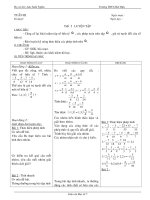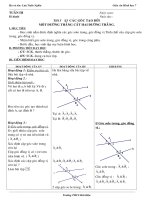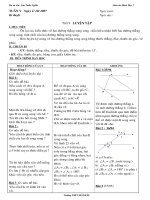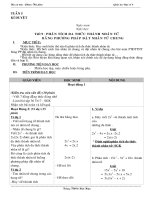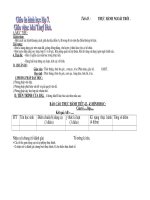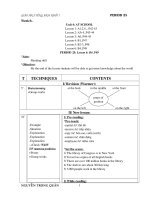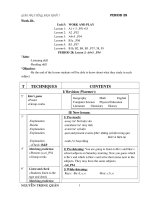- Trang chủ >>
- THPT Quốc Gia >>
- Ngoại Ngữ
Gaio an anh 7 tuan 5 3 cotvua soan xong day
Bạn đang xem bản rút gọn của tài liệu. Xem và tải ngay bản đầy đủ của tài liệu tại đây (227.42 KB, 10 trang )
<span class='text_page_counter'>(1)</span><div class='page_container' data-page=1>
<b>Week 5</b>
<b>Unit 3: at home</b>
<b>Period 13: section a- what a lovely home! </b>
<b>Lesson 1: A1</b>
Date of planning: 07/9
Date of teaching:
I. Objectives:
By the end of the lesson, Ss will be able to know the form of the exclamation to
express their feeling: What+ N! And know how to describe their rooms
II. Language content:
1. Knowledge:
Nouns: tub , shower, sink………..; Adjectives<i>: lovely, bright, favorite,</i>
<i>convenient……..</i>
<b> Grammar points: What +adj + N !Some adjs such as lovely, bright, favorite. </b>
convenient and learn some kitchen appliances
2. Skills: listening and reading comprehension
III. Teaching aidS :book, posters, tape and chalk
IV. PROCEDURE:
<b>Stage</b> <b>Steps/ Activities</b> <b><sub>arrangement</sub>Work</b>
<b>1. Warm-up</b> <i><b>* Wordsquare.</b></i> T-whole class
- Stick the poster on the board.
- Ask students to find 13 nouns of things in the
house.
- Get students to work in pairs to find out the
words.
- Divide the class into two teams, students from
each team go to the board and circle the words
they have found then write them down in the
column of their team.
- The game that has more words will win the
game.
<i><b>* Answer keys.</b></i>
shower, living room, kitchen, <sub>dishwasher</sub>
bookshelf, dryer, couch
lamp, sink, desk, stove, armchair
bench
<b>2. Presentation</b> <b>a. Pre-teach vocabulary</b>
- amazing (adj): đáng ngạc nhiên (visual)
F L E H S K O O B A
A S H O W E R P T R
L I V I N G R O O M
A N R E Y R D B S C
M K I T C H E N T H
P O D E H N S V O A
H C U O C H K S V I
</div>
<span class='text_page_counter'>(2)</span><div class='page_container' data-page=2>
- delicious (adj): ngon lành
- bringt (adj): sáng sủa
- interesting (adj): thú vị, tuyệt
- comfortable (adj): dễ chịu, tiện nghi
- modern (adj): hiện đại
<i><b>* Checking vocabulary:</b></i> Slap the board.
- Put the new words all over the blackboard. Team work
- Call two students or two teams of students to
the front of the class. Make sure they stand at an
equal distance from the board.
- Call out one of the new words in Vietnamese
loudly the two students must run forward and
slap the word on the board. The one who first
slaps the correct word is the winner.
- If the students play in teams, the winning team
gets one mark. Then ask two more students to
come forwards and the game continues until all
the words are slapped.
<b>b. Presentation dialogue.</b> Individual work
- Ask students to read the dialogue A1 on
page 29 – 30 and collect the exclamation
sentence
<i><b>* Model sentences.</b></i>
What a beautiful bathroom.
What an amazing kitchen.
<i>* Form: </i><b>what + a/ an + adj + noun</b>
<i>* Use: </i><b>to pay a compliment or to make a </b>
<b>complaint</b>
<b>3. Practice</b> <b>a. Word cue drill</b> T-whole class
- Prepare the cards with cues on them.
<b>* Cues.</b>
a/ kitchen/ amazing
b/ armchairs/ comfortable
c/ living room/ bright
d/ dinner/ delicious
e/ books/ interesting
f/ her house/ convenient
amazing bring delicious
comfortable modern
</div>
<span class='text_page_counter'>(3)</span><div class='page_container' data-page=3>
- Model the exchange and ask students to make
exchanges using the given cues. Pair work
<i><b>* Exchange: </b></i>
Student 1: The kitchen is amazing.
Student 2: Yes. What an amazing kitchen.
b/ The armchairs are comfortable.
Yes. What comfortable armchairs!
c/ The living room is bright.
Yes. What a bring living room.
d/ The dinner is delicious.
What a delicious dinner!
e/ The books are interesting.
Yes. What interesting books!
f/ Her house is convenient.
Yes. What a convenient house!
<b>4. Further Practice</b> <b>I. Mapped dialogue</b> Pair work
- Present the dialogue using symbols, cues,
visual… and have students make sentences.
- Call on some pair of students to demonstrate the
dialogue before class (open pairs).
- Have students work in pairs to practice the
dialogue.
<i>* Mapped dialogue</i>
<i><b>* Example dialogue.</b></i>
S1: This is my house.
S2: What a beautiful house!
S1: And this is my bedroom.
S2: It’s very nice. Where is the kitchen?
S1: It’s over there.
S2: Oh. What a modern kitchen!
S1: Yes. It’s very convenient.
<b>II. Writing.</b> Individual work
- Ask students to write a compliment, using the
This…….house
.beautifulAnd .bedroomIt .nice
…… …… ……
</div>
<span class='text_page_counter'>(4)</span><div class='page_container' data-page=4>
structure <b>what + a/an + adj + noun!</b> With the
cues in A2b on page 31.
<b>5. Homework</b> - Ask students to write the compliments A2 on
page 31 in their notebooks.
<b>* remark.</b>
………
<b>Period 14: </b>
<b>Unit 3: at home</b>
<b> </b>
<b>Lesson 2: A2 + A4 + Remember</b>Date of planning: 08/9
Date of teaching:
I. Objectives:
By the end of the lesson , Ss will be able to use the form of the exclamation<b>s </b>and then
write the exclamations to express the complaints and compliments<b>. </b>
II. Language content:
<b>1. Knowledge: </b>
“ What (a / an) adj + N ! /What +adj +Ns!”
<i> = How adj + the+N + tobe!</i>
<b> 2. Skills : </b>Writing and listening
III. Teaching aid: textbook, chalk ,board and pieces of paper
IV. proceduce:
<b>Stage</b> <b>Steps/ Activities</b> <b><sub>arrangement</sub>Work</b>
<b>1. Warm-up</b> <i><b>* Jumble words.</b></i> T-whole class
- Divide the class into two teams.
- Ask students from two teams to go to the
board and write the correct words.
- The team that writes more correct words first
will win the game.
tirbgh bright
coiliusde delicious
terintesing interesting
venveiontn convenient
deomnr modern
ratocblemof comfortable
<b>2. Presentation</b> <b>I. Pre-teach vocabulary</b> T-whole class
- awful (adj): dễ sợ, kinh khủng >< Beautiful
(antonym: wonderful)
- expensive (adj): đắt.>< cheap
(antonym: cheap)
</div>
<span class='text_page_counter'>(5)</span><div class='page_container' data-page=5>
awful
expensiv
e
bad
boring
wet
dry
(antonym: good)
- boring (adj): dở, chán >< interesting
(antonym: interesting)
- wet (adj): ướt, ẩm ướt
(antonym: dry)
<i>* <b>Checking vocabulary:</b> What and where.</i>
- Write the words on the board, put one word
in each circle.
- Have students repeat the words in choral.
- Rub out word by word but leave the circle.
- Go on until all the words are rubbed out.
- Point to each empty circle and ask students
to repeat chorally the English words.
- Ask students to go to the board and write the
words again in their correct circles.
<b>II. Presentation.</b>
- Use the picture on page 30 to elicit the
exclamation sentence. T-whole class
<b>Model sentence: What an expensive dress!</b>
<i>* Form: </i><b>What + (a/an) + adj + noun!</b>
<i>* Use: To pay a compliment or to make a </i>
complaint.
<b>3. Practice</b> <b>I. Word cue drill</b>
- Prepare the cards with cues on them.
- Model the exchange and ask students to
repeat.
- Ask students to use the cues to make
exclamation sentences.
- Get them to work in pairs. Pair work
<i><b>* Cues</b></i>
a. awful restaurant
b. wet day
c. boring party
d. bad movie
e. expensive shoes
</div>
<span class='text_page_counter'>(6)</span><div class='page_container' data-page=6>
a. The restaurant is awful.
Yes. What an awful restaurant!
b. It is wet today.
Yes. What a wet day!
c. The party is boring.
Yes. What a boring party!
d. The movie is bad.
What a bad movie!
e. The shoes are expensive.
Yes. What expensive shoes!
<b>b. Comliments</b>
a/ What a great party! Group work
b/ What a bringt room!
c/ What an interesting movie!
d/ What a lovely house!
e/ What a delicious dinner!
f/ What a beautiful day!
4.<b>Production</b> T: play the tape of A4.<sub>Ss: listen and repeat after the teacher.</sub>
T reviews all grammar points in section A:
+ The exclamations
+ There is/ there are
+ prepositions of places.T: play the tape of A4.
Ss: listen and repeat after the teacher.
T reviews all grammar points in section A:
+ The exclamations
+ There is/ there are
+ prepositions of places.
Teacher _
whole class
<b>5. Homework</b> <sub>complaints and ten sentences of compliments. </sub>T: request Ss to write ten sentences of
Prepare the next lesson “Unit 3 : B1”
Ss: listen and note downT: request Ss to
write ten sentences of complaints and ten
sentences of compliments. Prepare the next
lesson “Unit 3 : B1”
Ss: listen and note down
Individual
work
* remark:
...
...
<b>Unit 3: at home</b>
<b>Period 15: SECTION B: B1 + B2</b>
Date of planning : /9/2009
</div>
<span class='text_page_counter'>(7)</span><div class='page_container' data-page=7>
1. <b>Knowledge : </b>By the end of the lesson , Ss will be able to ask answer about jobs
according to the structures
+ What do / does + S + do ?
+ Where do / does + S + work ?
And know some names of jobs in English
2. <b>Skill : </b>listening comprehension and practice the dialogue
<b>B. Teaching aid : book, chalk, picture and cassette</b>
c. procedure.
<b>Stage</b> <b>Steps/ Activities</b> <b><sub>arrangement</sub>Work</b>
<b>1. Warm-up</b> <i><b>* Shark attack.</b></i> T-whole class
- Cut out a shark and a schoolgirl on card.
- Draw some steps on the board, and the sea
around the steps.
- Stick the girl on top of the steps, and the shark is
in the sea.
- Draw 11 gaps for the word COMFORTABLE.
- Get students in teams (or ask them as a whole
class) to guess the letter in each gap. If their guess
is right, they’ll get one mark. If their guess is not
right, the girl has to step down.
- The game can continue with some more words.
DELICIOUS
AWFUL
AMAZING
EXPENSIVE
BORING
WET
<b>2. Pre-reading</b> <b>a. Pre-teach vocabulary</b> T-whole class
- raise (v): nuôi (translation)
- grow (v): trồng (picture)
- take care of (v): chăm sóc
- cattle (n): gia súc
(explanation: farm animals such as oxen, bulls,
cows and calves)
- newspaper (n): báo ngày (realia)
- journalist (n): nhà báo
(explanation: a person engaged in newspaper
work)
<i><b>* Checking vocabulary</b>: Rub out and Remember.</i>
- Rub out the new words one at a time.
</div>
<span class='text_page_counter'>(8)</span><div class='page_container' data-page=8>
- When all the words are rubbed out, go through
the Vietnamese list and get students to call out the
English words.
- If there’s time, get students to come to the board
and write the English words again.
<b>b. True/ False statements prediction</b> Individual work
- Give a poster of 5 statements on the board.
- Ask students to keep their books closed, read the
statements on the poster and guess which
statements is true and which is false.
<i><b>* Set the scene:</b></i>This is a dialogue between Lan
and Hoa. They’re talking about Lan’ parents’ job
- Get students to read the statements and work
with their partners in 3 minutes. Pair work
- Give feedback.
1/ Hoa’s father is a worker.
2/ Hoa’s mother does housework and helps on
the farm.
3/ They don’t like their work.
4/ Hoa has a younger brother.
5/ He/ she is 8.
<b>3. While reading I. Reading and checking prediction</b> T-whole class
- Get students to read the dialogue B1 on page 33
and check their prediction.
- Ask students to correct if the statements are not
true.
<b>II. Filling the form</b>
- Have students read B2 on page 34 to know more
about Lan’s family and then work in pairs to fill in
the form.
Pair work
<b>III. Practice asking and answering.</b>
<b>Gue</b>
<b>ss</b>
<b>Che</b>
<b>ck</b>
<b>Correction</b>
1 F Hoa’ father is a
farmer
2 T <sub></sub>
3 F They love their
work
4 F Hoa has a
<b>Hoa</b> <b>Lan</b>
Father’s job Farmer Doctor
Mother’s
job
Housewif
e
Teacher
Brother’s
job x Journalist
</div>
<span class='text_page_counter'>(9)</span><div class='page_container' data-page=9>
- Have students look at the form and practice
asking and answering about jobs. Pair work
- Get students to use the structure: What’s… job?
Ex: What’s Hoa’s father’s job?
(Help students distinguish three ‘ in the question)<b>s</b>
<i><b>* Answer keys.</b></i>
1/ What’s Hoa’s father’s job?
He’s a farmer.
2/ What’s her mother’s job?
She’s a housewife and help on the farm.
3/ What’s her sister’s job?
She’s a student.
4/ What’s Lan’s father’s job? He’s a doctor.
5/ What’s her mother’s job?
She’s a teacher.
6/ What’s her brother’s job?
He’s a journalist.
<b>4. Post reading</b> <i><b>* Survey</b></i> T-whole class
- Ask students to write the form in their notebooks.
- Run through the questions.
1/ How old is (your family) member?
2/ What’ his/her job?
3/ Where does he/she work?
- Get students to ask their partners and write the
information in the form.
- Give feedback and ask students to tell the class
about their partner’s family members.
<b>Eg:</b>
T: Mai, who is your partner?
S: It’s Nam.
T: Yes. How old is Nam’ father?
S: (answer)
T: What’s his job?
S: (answer)
<b>Memb</b>
<b>er</b> <b>Age</b> <b>Job</b> <b>Place ofwork</b>
Father
</div>
<span class='text_page_counter'>(10)</span><div class='page_container' data-page=10>
T: Where does he work?
S: (answer)
<b>5. Homework</b> - Write their family members’ jobs/ ages/ place of
work in their notebooks. Individualwork
<b>* Remark.</b>
………
………
<b>_________________________________________________________________</b>
Date: …… …… / ./ 2012
</div>
<!--links-->

